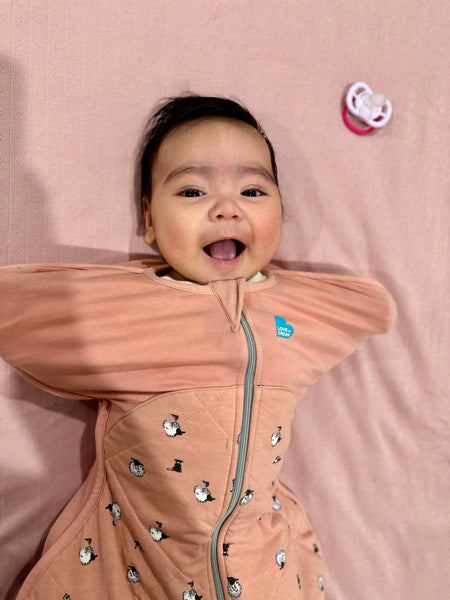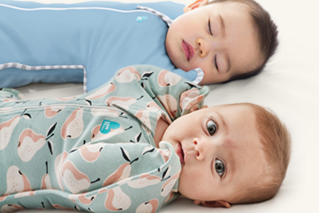Where should twins sleep?
It is your decision whether to put your twins down to sleep together or apart. Red Nose Australia recommends that twins sleep in their own safe space, a cot or bassinet, in the parent/caregiver’s room for the first six to 12 months.
If this isn’t possible in temporary situations, such as travelling or visiting family, twins can share the same safe sleep space. In these circumstances, do not use loose bedding and always put your children to sleep on their backs with their feet at opposite ends of the cot. We do not advise co-sleeping with your children.
Important: always follow safe sleep guidelines.
Are there any benefits of twins sleeping together in the same room?
Every family is different. Below, find some of the common reasons why parents and caregivers like their twins sleeping in the same room:
- Twins can comfort one another during the night which will, in turn, help them to settle.
- If sleeping separately, you can place the twins’ cots beside one another so that the babies can see and touch each other. This can help them to bond and settle. You might need to be flexible, as one child might prefer a cot while the other may sleep better in a bassinet.
Sharing a room with your children for the first six to 12 months is recommended by Red Nose Australia to reduce the risk of SIDS.
Can twins sleep in the same bassinet or cot?
It’s the parent/caregiver’s decision whether to sleep twins in the same cot (formally known as co-bedding). You must not use a bassinet if twins are sharing the same sleep space due to limited room and safety concerns.
Red Nose Australia advises against twins sharing a cot as this can increase the risk of SIDS while the NHS states: ‘You can put your twins to sleep in a single cot while they're small enough.’ It’s important to do your own research and make a decision based on your circumstances.
Some parents and caregivers choose to swaddle their babies before sleep to ensure they are comfortable. Our award-winning Swaddle Up™ enables your little one to self-soothe with ease. You must stop swaddling when your child starts to show signs of rolling over (usually between three to five months of age).
At what age should twins stop sleeping together?
The age at which twins stop sleeping together is a personal decision for the parent or caregiver. If your twins disturb each other’s sleep and you have the space available, you might want to give them separate rooms when they are over the age of 12 months.
Important: Sharing a room with your children for the first six to 12 months is recommended by Red Nose Australia to reduce the risk of SIDS.
Do twins sleep better next to each other?
Every baby is different and it is your personal choice whether to co-bed twins or not. Red Nose Australia suggests the safest way to sleep twins at home is to place them in their own cot and follow the Red Nose safe sleeping guidelines.
Some studies suggest that twins sleep better next to each other, as it helps them to regulate their body temperatures and sleep cycles.
Can twins nap together outside of the cot?
We recommend following the same routine for naps as you do at bedtime. This will help your children to settle and better understand sleep cues. Twins who eat at the same time during the day are more likely to want to nap at the same time too.
If your children safely sleep in the same cot together during the night, then they can do so during the day too. You must stop co-bedding/swaddling twins once one of them has started to show signs of rolling over.
Tips for putting twins and multiples to sleep safely
Every child is different, but the four foundations to a healthy sleep routine remain the same:
- Setting up baby's day and night
- Creating the ideal safe sleep environment
- Responding to tired signs
- Self-settling assistance
Below, discover our top tips on putting twins and multiples to sleep safely.
1. Setting up your children’s day and night routines
When establishing your children’s day and night routines, aim to have them on the same or similar timings if possible. For example, children who eat together are likely to nap together too.
If you have someone to help you, feeding, bathing, and changing nappies can be done simultaneously. When alone, attend to one baby, then the other, etc. A newborn routine will lay the foundations for a healthy sleep pattern for years to come.
2. Creating the ideal sleep environment
It’s possible for similar-sized twins and triplets to share a large sleep space safely. Multiples that regularly sleep together are unlikely to disturb each other’s sleep.
If putting twins and multiples to sleep in the same space, always follow the below safety guidelines:
- Put your children to sleep on their back.
- Ensure the mattress is clean, firm, flat, and the right size for the cot.
- Do not use excess or loose bedding/pillows.
- Place your children in the feet to foot position.
Always follow Red Nose Australia’s recommendations for sleeping twins safely at home and when separate cots are not available. For higher order multiple births (triplets, quadruplets, quintuplets), please contact your health professional for advice on providing a safe sleep environment for each baby.
3. Responding to tired signs
Tiredness or overstimulation can be caused by family visits or when your little one has missed a daytime nap. Below, find common signs that your newborn is tired:
- Closing their fists.
- Yawning.
- Making jerky arm and leg movements.
- Arching their back.
- Frowning.
- Staring into space.
4. Self-settling assistance
Self-settling is when a child wakes up and falls back to sleep without assistance from a parent or caregiver. In the first few months, most babies need hands-on assistance, such as shushing, rocking, or holding.
Around the four-to-five-month mark, a baby’s circadian rhythm matures, and you will start to notice a change in their sleep patterns. This is a crucial time to introduce self-settling as it will help your child fall back to sleep without assistance during the night.







